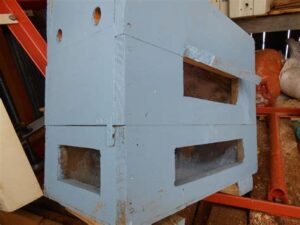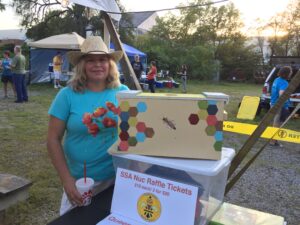Final report for FNC18-1145
Project Information
In 2017, a sub group of Saint Louis Beekeepers club (Sustainable Stock Apiary or SSA) started a honey bee queen rearing project at 1259 Stephen Jones Avenue in Wellston, Missouri. The Sustainable Stock Apiary is a honey bee yard consisting of established "parent" colonies and queen-rearing "nucleus" boxes, strategically situated in north St. Louis, an area that has recently been identified by SLU Professor and bee researcher Dr. Geraldo Camilo as above average for bee species diversity and bee population density. With the SARE grant award in 2018, SSA was able to significantly scale up the number of queen rearing boxes and supporting equipment to increase locally mated honey bee queen production. The goal is to provide the St. Louis area beekeeping community locally raised and adapted queen bee stock.
This proposal plans to address the problem of the lack of available, local, survivor honey bee queens for beekeepers. We plan to address this problem by raising queen stock from local survivor colonies for sale to beekeepers and also to teach sustainable honeybee queen rearing practices to beekeepers. In 2017 we shared hive resources from our own apiaries at the newly formed SSA Queen Rearing Apiary and began practicing sustainable queen rearing under the direction of Jane Sueme, Certified Master Beekeeper. We tested our hives for diseases and used the pathogen-free colonies as starter stock for our queen rearing project. We had success in raising a few queens, however we need to explore methods of queen rearing that produce a higher quantity of quality queen bees and methods of “banking” those queens for availability to beekeepers throughout the beekeeping season. Providing queens from stock that successfully overwinter in our zone to local beekeepers greatly increases their springtime hive strength and honey production, while decreasing cost of stock replacement and apiary operation. The location for the apiary was selected because very few managed bee hives are in the area and it allows for easy access for field days and teaching workshops.
- Produce 100 locally-raised and adapted honey bee queens that successfully overwinter each season.
- Provide access to this local queen stock by making the queens available for sale to local beekeepers.
- Document over-wintering success of queen honey bees produced, which will include two cycles during the 23-month period of the grant.
- Share methods, outcomes and education with local beekeepers through field day workshops, beekeeping association email communication and meetings, a quarterly electronic newsletter to a database of the St. Louis region’s beekeeping community, social media and regional club presentations.
Cooperators
- (Educator and Researcher)
- (Educator and Researcher)
- (Educator and Researcher)
- (Educator and Researcher)
- (Educator and Researcher)
- (Educator and Researcher)
- (Educator and Researcher)
- (Educator)
- (Educator and Researcher)
- (Educator and Researcher)
- (Educator and Researcher)
- (Educator and Researcher)
- (Researcher)
- (Researcher)
Research
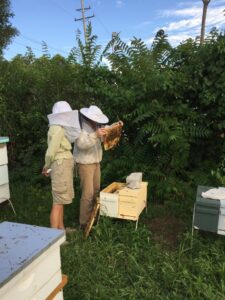
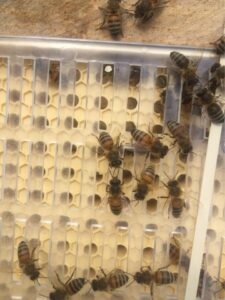
A number of our SSA members took queen rearing classes at the recent Heartland Apicultural Society annual conference held in St Louis, MO this July 2018. There were pertinent recommendations made regarding adding large numbers of nurse bees to our starter colonies when grafting. Additionally, another suggestion we are utilizing is the use of California queen cages to protect queen cells from being destroyed by first emerging queen.
2019 Starter Colony
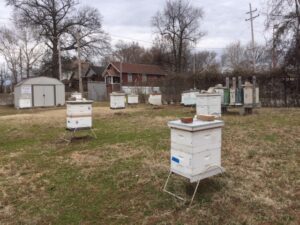
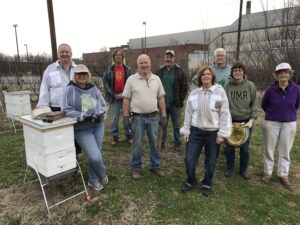
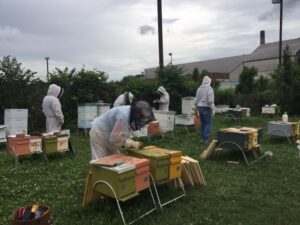
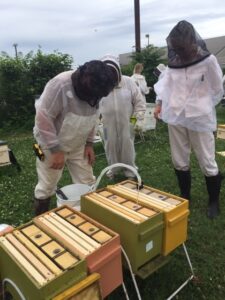
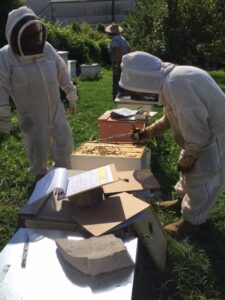
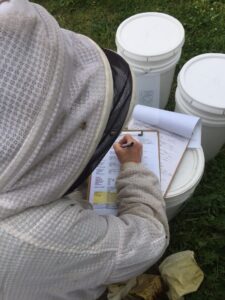
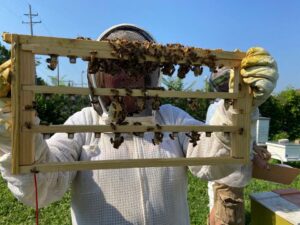
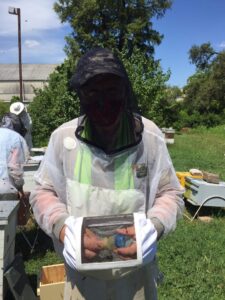
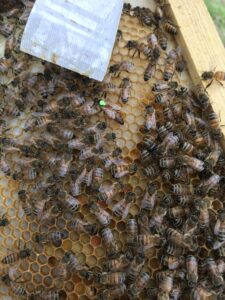
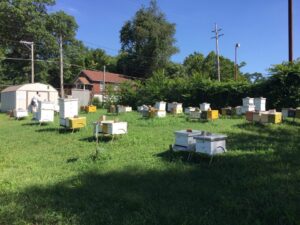
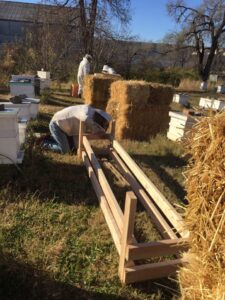
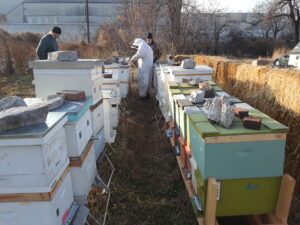
Several beekeepers attended a beekeeping conference sponsored by the Heartland Apicultural Society at Washington University in July, 2018. They learned several methods of queen rearing that we might consider utilizing at the apiary.
The group faced several challenges in raising queens. The spring 2018 season was unusually cold and wet, causing the bees to remain inactive until late April. The overwintered hives suffered loss of bees so we had to rebuild resources to continue with the queen rearing. This caused us to start queen rearing behind schedule and with fewer resources. Hive beetles were also a challenge. We also destroyed a hive that showed pathogens on test results.
We plan to address these challenges in the second year of the queen rearing project by starting as early as the weather will allow. Though the weather is out of our control, we will be ready. Also, we will purchase package bees to increase our supply of bees in order to be more successful at raising local queens. Additionally, we will supplement the colonies with pollen and sugar syrup to help them survive the weather until enough natural pollen is accessible to the colonies. We plan to aggressively address the hive beetles with traps in each nuc and hive to help limit the hive beetle population. These actions along with the additional knowledge gained through the HAS Queen Rearing class will help the teams to be more successful at queen rearing this season.
We have learned valuable lessons during our first year of queen rearing. We learned that we need more resource hives to supply the quantity of nurse bees necessary for successful queen rearing. We will increase the number of bees shaken into nucs when placing queen cells into the nuc. We learned that several elements affect the success of queen rearing, some of which are out of our control, such as the weather. We learned that creating queens by splitting hives is the most successful method we have tried. While grafting, cloak board and nicot methods were attempted, they didn’t produce the quantity of queens that they potentially could have. We will continue to explore these queen rearing methods to determine which method best suits our situation.
While we had several challenges and learned valuable lessons, the team did experience some success. The queen rearing team works very well together. They are flexible and willing to jump in and help each other whenever they can. The team members are willing to share information and experience with each other. We did learn that we need to better utilize the record-keeping software used to track hives and queens. This will help us to have better continuity and communication with regard to the status of each hive and the next task needed. This camaraderie will help with future queen rearing success. Our team is very dedicated and disciplined and are taking the extra time to tend the hives, working around job schedules which often includes traveling out of town. When asked if they would continue, the team almost unanimously stated that they would return and keep learning and practicing queen rearing. They are dedicated to addressing the issue of a lack of local queen stock for local beekeepers.
2018: 11 Farmers participating in research.
2019 additions:
The harsh winter of 2018 with Polar Vortex left us with only 4 hives. A pathology report shows that 2 of the hives that died in January had viruses known to be transmitted by varroa mites.
We purchased 8 packages of bees to use as resources but not as stock to raise queens. This decision was based on 2018’s lesson we needed more nurse bees, honey frames and pollen for queen rearing.
Nicot method again without desired results.
Starter Finisher Colony Method gave us the best results.
- Starter Colony (5 frame nuc box) 2 frames of honey, 2 frames of pollen, water, sugar water feeder, 6 frames of nurse bees shaken into nuc box. The Starter Colony is set up the day before you graft.
- Graft appropriate aged larva that has a good amount of royal jelly. Transfer larva into jzbz cups with the royal jelly without flipping the larva over but with same orientation as it was in comb. When working with the frame of larva and the cups with transferred larva, care needs to be taken to keep them from drying by placing a damp towel over them. Work calmly but quickly to minimize time out of hive and get grafted cups into Starter Colony.
- Choose a strong hive to use as Finisher Colony. Find the queen and place her below the queen excluder. Move uncapped larva frames above the queen excluder. The nurse bees will move above the queen excluder to care for the larva. Prepare the Finisher Colony the same day you graft.
- 1 day after grafting bar was placed in Starter Colony the nurse bees should have started adding royal jelly to the cups and started to form the Queen Cells. 24hrs after grafting move these to Finisher Colony.
- Move queen cells from Finisher Colony to Mating Nuc 12 days after grafting.
- Do not check for new queen until 10-14 days. It has been determined that the new queen is more readily accepted after this waiting period.
Queen grafting data
| Queen Grafting 2019 | ||||||||||||
| Batch | Starter Colony date started | Graft date | Origin of larva | Number of cups | Transfer to finisher Colony date | Set up Mating Colony date | How many queen cells | Date transferred to Mating Colony | Emerge date | Queens emerged | Queens mated | Named |
| 1 | 4/26/19 | 4/27/19 | JP-1 | 12 | 4/28/19 | 5/4/19 | 5 | 5/5/19 | 5/8/19 | 5 | 3 | 19-JP1-T4-A (in Team4 hive); Sell 19-JP1-T4-B |
| 2 | 5/13/19 | 5/14/19 | JP-1 | 20 | 5/15/19 | 5/23/19 | 5 | 5/24/19 | 5/26/19 | 4 | 4 | 19-JP1-T4-C Requeen PkgQ A; Sell 19-JP1-T4-D, E & F |
| 3 | 6/10/19 | 6/11/19 | Blue queen granddaughter | 20 | 6/13/19 | 6/18/19 | 12 | 6/20/19 | 6/23/19 | 12 | 10 | 19-BQ1-T4-A to J |
| 4 | 7/8/19 | 7/9/19 | Blue queen granddaughter | 25? | 7/11/19 | 7/16/19 | 21 | 7/17/19 | 7/21/19 | 20 | 13 | 19-BQ1-T4-K to W |
2019 Queen disposition:
- 35 queens were raised by grafting.
- 1 queen was raised from Nicot Method
- 3 queens were raised by OTS Method
- 2 of these queens were used to requeen the purchased bee packages.
- 1 queen was used to requeen 1 of our survival colonies with bad temperament.
- 6 queens went to SSA members
- 1 queen and nuc was raffled off at Annual Field Day.
2019: 10 Farmers participating in research.
2020 Queen Raising Data
| Mating Nuc | Queens | Grafted/OTC | Queen Mother | Notes |
| 1 | 20-BQ1-H2 | OTS | 19-BQ1-H | SOLD 7/14/2020 |
| 1 | 20-JP1 | OTS | JP1 | QC installed 7/20 from Hive L (19-JP1) |
| 2 | 20-BQ1-H1 | OTS | Moved to Hive N for resource hive | |
| 3 | 20-JP1-A2 | OTS | Moved to Hive Q for resource hive | |
| 4 | 20-BQ1 | OTS | SOLD 7/14/2020 | |
| 4 | 20-BQ1-A2B | OTS | 19-BQ1-A2 | QC installed 6/16 Mother Q, SOLD 7/14/2020 |
| 4 | 20-JP1 | OTS | JP1 | QC installed 7/20 |
| 5 | 20-BQ1-1 | OTS | 20-BQ1-1 | SOLD 7/14/2020 |
| 5 | 20-JP1x2 | OTS | 20-JP1-A | QC installed 7/20 from Hive LK (20-JP1) |
| 6 | 20-JP1 | OTS | SOLD | |
| 6 | 20-BQ1-A2x | OTS | 20-BQ1-A2 | QC installed 6/16 Mother G |
| 8 | 20-DG1-A1 | OTS | Moved to Hive "V" | |
| 10 | 20-BQ1-A1A | OTS | 20-BQ1-A1 | SOLD 7/14/2020 |
| 10 | 20-BQ1-A1x1 | OTS | 20-BQ1-A1-A | QC's started 7/14/20 |
| 11 | 20-BQ1-A4 | Graft | Moved to Hive "U" | |
| 14 | 20-BQ1-A2 | Graft | Moved to Hive "T" | |
| 17 | 20-DG1-C1x1 | OTS | 20-DG1-C1 | |
| 17A | 20-DG1-A-2 | OTS | 20-DG1-A | |
| 18 | 20-JP1-A2 | OTS | 20-DG1-A | Swarm cell from Hive "B", SOLD 9/9/2020 |
| 19 | 20-JP1-A1-A | OTS | 20-JP1-A1 | QC from "C" installed 6/16 SOLD 7/14/2020 |
| 19 | 20-JP1-A1-A1 | OTS | 20-JP1-A1-A | |
| 21 | 20-BQ1-A2A | Graft | 19-BQ1-A2 | QC from "M", SOLD 7/14/2020 |
| 21 | 20-Swrm-Ax1 | OTS | 20-Swarm-A | QC from "E" Mother Q 20-Swarm-A 7/20/20 |
| 22 | 20-BQ1-A3 | OTS | 20-BQ1-A3 | |
| 24 | 20-BQ1-A3-2 | OTS | 20-BQ1-A3 | |
| 27 | 20-BQ1-A4A | Graft | "U" 20-BQ1-A4 | |
| 28 | 20-BQ1-A4B | Graft | "U" 20-BQ1-A4 | |
| 30 | 20-JP1 | Graft | JP1 | |
| 32 | 20-JP1 | Graft | JP1 | |
| 33 | 20-JP1 | Graft | JP1 | |
| 38 | 20-DG1-C1-B | OTS | 20-DG1-C1 | |
| 39 | 20-DG1-C1-A | OTS | 20-DG1-C1 | SOLD 9/16/2020 |
| 40 | 20-BQ1-A2-2 | OTS | 20-BQ1-A2 | SOLD 9/16/2020 |
| 41 | 20-BQ1-A2-3 | OTS | 20-BQ1-A2 | SOLD 9/16/2020 |
| 42 | 20-Swarm-A2 | OTS | 20-Swarm-A2 | SOLD 9/16/2020 |
| 43 | 19-BQ1-U1 | OTS | 19-BQ1-U | SOLD 9/18/2020 |
2020 Queen Disposition
36 queens were raised from this SSA Apiary stock, 28 by OTS and 8 by grafting, see chart above.
- 14 of these queens were bred, mated and sold.
- 22 of these queens were raised to add to established colonies in the apiary to overwinter in the apiary. A number of these will be sold in Spring, 2021 as starter 5-frame nucleus colonies, a number will be maintained in this apiary, and the balance distributed to SSA member farmers further for breeding at their personal apiaries.
Summary of 2020
The apiary began Year 3 with 11 over-wintered hives: A, B, C, D, E, F, G, H, I, J, K
Before queen rearing began for the third season, the apiary lost hives A (alive in the spring, but succumbed to disease or chilled brood). F and J were winter dead outs.
Hive A frames were removed and destroyed and the remaining equipment was cleaned with a 5% bleach wash. Using OTS (called the On-The-Spot queen rearing method), SSA repopulated hive A from hive C stock. Hives F and J were removed.
SSA protocol is to test all queen-rearing candidate colonies for pathogens. Due to a 100% increase in testing fees with our established lab, we chose to sample 4 of the 8 winter survivors. The below report indicates varying amounts of pathogens present. This quantifiable data reporting is new, differing from previous years where we received confirmation only, not pathogen load data. When we inquired for interpretation, the National Agricultural Genotyping Center (NAGC) lab was unable to qualify the results. We will provide NAGC our working logs for their review as they are collecting data from many of their clients to help them measure the impacts of pathogen load.
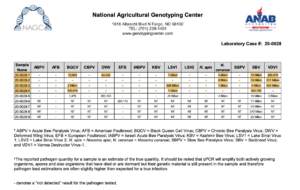
2020 Spring SSA experienced a lot of swarming. To help control these swarming tendencies, the over-wintered queens were moved to 5-frame nuc boxes and allowed to get established in a new hive. The extra queen cells in the hives preparing to swarm were used to create OTS (On-The-Spot) replacement queens for these colonies, rendering those hives unavailable for grafting.
Many of the resource hives were not available for grafting due to similar swarm tendencies, so it was decided to increase the number of resource hives from 10 to 20 so that we’d have bees, honey and pollen - all critical resources for the purpose of queen rearing. We selected 10 colonies from the apiary stock that had the characteristics we wanted to propagate.
As in previous years, colonies were sampled/tested for varroa mite load at season's peak, in August. The following is a chart of the 8 colonies we "spot" tested from the apiary, with mite infestation levels noted. The standard threshold where treatment is indicated for mite infestation is 2-3%, at this time of the year. As in previous years, our mite loads are below threshold, so we did not treat for varroa mite control. We have not had to treat any of these hives for varroa mites since inception. We believe mite levels continue to be low, even as the density of bees in this apiary continues to increase, due to a number of positive factors, including survivor stock genetics from the original breeding stock brought to the yard prior to the start of this grant; early spring pathogen sampling and remediation; as well as colony manipulation which breaks the cycle of mite reproduction, keeping their numbers manageable by the colony's behaviors, including grooming and hygienic brood rearing.
| HIVE | # OF MITES IN SAMPLE | SAMPLE SIZE | % INFESTATION |
C |
2 |
350 |
.57% |
L |
0 |
297 |
0 |
E |
1 |
430 |
.23% |
B |
0 |
198 |
0 |
D |
1 |
236 |
.42% |
H |
0 |
366 |
0 |
N |
0 |
320 |
0 |
V |
5 |
440 |
1.1% |
2020 established queens/colonies going into winter -
44 total colonies are established in the SSA apiary at the close of 2020.
- 8 successfully over-wintered from 2019
- 17 additional colonies with queens raised in Summer 2020 to sell in Spring 2021
- 5 additional colonies with new queens, established to provide critical resources
- 14 OTS queens raised in colonies when the original queens were harvested to sell
The Apiary Winter Configuration -
(13) 8fr single deep: A, D, I2, P, U, T, 17A, D2, E2, L2, K2, L, M
(9) 8fr double deep: E, G, H, I, 6, V, Q, O, N
(1) 10fr single deep: B
(1) 10fr double deep: C
(8) 5fr double nuc: 5, 4, S, 22, 24, 30, T2, 1
(5) Apartments 2 5fr single nucs: 19/21, 27/28, 32/33, 38/U2, B2/C2
(1) Apartment 2 4fr single nucs: 10/17
Assessment of 2020: Due to COVID concerns and restrictions, we began the season working as a socially distanced group in the apiary, with follow-up Zoom meetings to review progress and do planning. When grafting for queen production, we formed a small group with experienced and inexperienced SSA volunteers. One benefit of this was that more beekeepers were given the opportunity to try their hand at grafting as we had 2 new members wanting to learn queen-rearing join our group. It was a total group effort and a good opportunity to educate new members, share and pass along knowledge.
As we experienced last season, the number of productive resource hives directly impacts our ability to raise quality queens. While we had 8 resource hives to start with, reproductive swarming made hives unavailable for critical periods of the queen rearing season. A decision was made to double resource hives by selecting the best of the colonies with bred queens to add to the Apiary's resource stock.
Using the metric for queen sales as success we didn’t out-perform last year’s numbers. We could have exceeded our previous year's queen sales significantly, but we decided to take the long term approach to accomplish the following goals - increasing our resource hives to continue both queen-rearing and education at the Apiary; sell a number of over-wintered "survivor" queens in established colonies to local beekeepers in Spring 2021, and distribute mating queens to participating member farmers at the end of the project, also Spring 2021.
Educational & Outreach Activities
Participation Summary:
This presentation was created to be used at meetings to share information about the SSA queen rearing project funded through SARE. StL SSA presentation
Annual Field Day (2017, 2018, 2019) - Last year approximately 75 people attended our pot-luck dinner; a purpose-presentation was conducted on-site; a tour of the bee yard was provided; coincidentally, a swarm was spotted and collected. This event is widely publicized and open to all. RSVP is suggested so we can manage drinks and BBQ (paid for by our club, the St. Louis Beekeeper's). Attendance in August 2018 matched the 2017 pot luck event. A tour of SSA apiary was provided by SSA team members with discussions of queen rearing methods utilized by our teams. There were several beekeepers from outside the St. Louis Metropolitan area at this event including a representative of a beekeeping club from Northwest Missouri. A lively discussion was started with attendees about queen rearing and how to determine hygienic trait in a brood. We had a good open forum that was interesting and thought-provoking. Raffle activity was a big success at the 2019 event - a nuc from the yard!
Jeanne Koebbe represented us at the Ferguson-Florissant School District celebration at Little Creek Nature Center, October 2018. She took beekeeping equipment for demonstration and gave an overview of our FNC18-1145 project. This was an open house at Little Creek with many members of the community participating.
2019
Jeanne Koebbe presented an overview of SSA project to St. Louis Beekeepers Club January 2019. 50 club members were in attendance.
Jeanne Koebbe and Connie Bachmann presented an overview of SSA project to Bellerive Acres Community Association February 2019. There were 12 participants in attendance. This organization plans social events and garden workdays in the community. They maintain the gardens which are the islands and entrance to the community. They have applied for and received grants for their work. The group was very interested in bees and asked very good questions
Various members presented for the 2019 year, in 2019 and early 2020, with a 23-slide PowerPoint presentation, see attached. Listed are the dates and members.
Updated presentation StL SSA presentation 2019
Saint Louis Beekeepers - J. Koebbe presented on July 23, 2019
Jefferson County Beekeepers - J. Sueme presented on December 10, 2019
Ste Genevieve - J. Patterson presented on January 6, 2020
Parkland Beekeepers - J. Sueme 2020 - scheduled
St Clair County (IL) Beekeepers - J. Sueme presented on January 31, 2020
Three Rivers Beekeepers - J. Sueme scheduled for Feb 17, 2020
Eastern Missouri Beekeepers - K. Smith to be scheduled
Rolla Bee Keepers - J. Sueme -scheduled to present Feb 23, 2020
Parkway North High School - possible presentation to Lexus Eco-Challenge winners of $7000 cash award for backyard bee hive
2020
SSA members reached out to Saint Louis Community College at Meramec' Bee Club to engage their students to participate in the 2020 summer management at the SSA apiary. Due to COVID-19, these plans were suspended. No other bee clubs were meeting in person for the remainder of the year and no other outreach efforts were offered.
Our education and outreach was strictly limited due to the COVID-19 pandemic. The group members have committed to continuing both queen-rearing at the apiary and outreach to the local and regional beekeeping community, post-pandemic.
When we have educational grafting sessions in the future, we will strive to prepare 2 "Starter" and "Finishing" colony set-ups. The new beekeepers we are teaching queen-rearing skills will work with one set of Starter/Finisher colonies and the established beekeepers will use a separate set of Starter/Finisher colonies for their grafting. This will allow both our education mission and goal of rearing queens to be realized.
Learning Outcomes
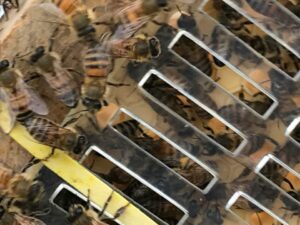
2019
- Queen rearing, while simple, requires large amounts of bee resources (bees, honey and pollen).
- Beekeeper needs to recognize environmental influences and plan around these influences. If rain is forecasted in queen rearing time frame, adjust the start of grafting.
- Queen rearing can’t start until evidence of drones.
- Graft larva that is the size of a comma and is in a good amount of royal jelly
- Queen rearing is most successful when there is a nectar flow.
- Making Mating Nucs for all of the queen cells that have been made takes a lot of bee resources and beekeeping labor. Most SSA beekeepers are employed full time and can only come to the apiary after work. Plan making the Mating Nucs so that most of the SSA Beekeepers can help in this labor after working hours.
- Do not check for new queen until 10-14 days. It has been determined that the new queen is more readily accepted after this waiting period.
2020
- Control swarming in Spring by moving queens in resource hives to separate 5-frame hives in mid April.
- Will benefit immediately with strong OTS (on - the - spot) queen cells.
- Begin grafting with full number of resource hives available mid-May.
- Increase number of resource hives.
- Create small group of teachers to standardize grafting procedure and oversee grafting efforts. When teaching, double the number of "Starter" and "Finisher" hives so that educating and practicing can be done without affecting our queen production.
Project Outcomes
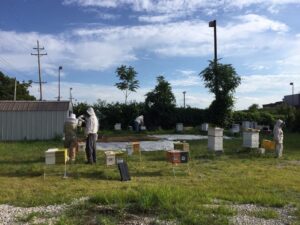
SSA Queen Purchase Survey 2019
Customers/recipients of the queens raised at the SSA yard in 2019 completed a survey of their experience with the queens and were asked to provide feedback on specific behaviors and other criteria (see graph above). At year-end, the average ranking of these queens was 4 out of 5 with 75% of the queens sold are still alive, in their respective hives. More than half of the recipients indicated they would purchase SSA queens again.
SSA Queen Purchase Survey 2020
Customers/recipients of the queens raised at the SSA yard in 2020 completed a survey of their experience with the queens and were asked to provide feedback on specific behaviors and other criteria (see graph above). At year-end, the average ranking of these queens was 3.8 out of 5. All of the recipients indicated they would purchase SSA queens again.
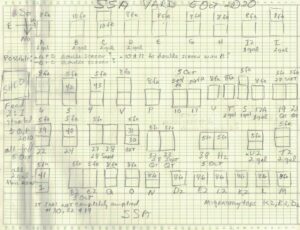
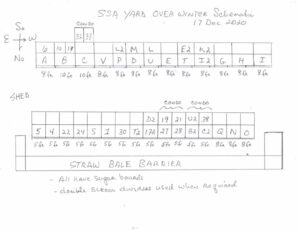
Recommendation for similar queen breeding projects to be structured as a grant period of 3 to 10 years for full development of a genetic or adapted line. Refer to Illinois Queen Initiative SARE Grant FNC10-822 as reference; Certified Master Beekeepers Rusty Burlew's articles on honeybee genetics and breeding http://www.honeybeesuite.com/honey-bee-genetics-wheres-the-miracle.
